Reference Manager
![]()
Imports geometry, such as WIRE files and other supported file formats, to reference data (WREF) files. Using referenced data lets you to work with large data sets while maintaining interactivity in Alias.
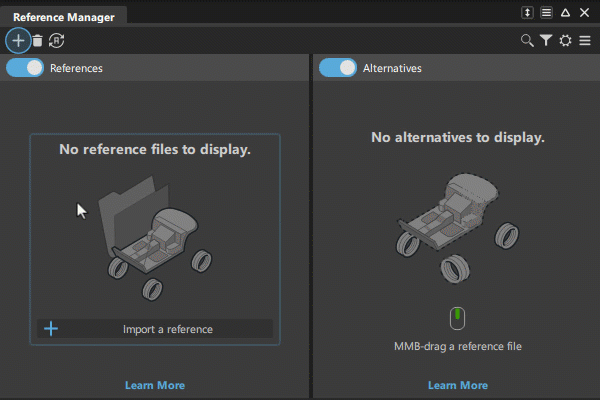
You can also use it for alternative shading and comparisons for design reviews as well as a way to support collaborative workflows on design projects. In addition to generating WREF files, the Reference Manager also provides the following features:
- Real time notification of out-of-date and missing referenced or source data.
- Direct access to the locations of source geometry and their associated references (see Reference Manager context menu).
- Ability to designate reference directories so that all referenced data can be centralized in one location (see Set file locations for reference data).
- Ability to create alternative shading comparisons for design reviews (see Reference Alternative workflows).
- Import Alias supported files, such as CATIA V5, directly to references, including reference assemblies (see Reference Assemble workflows).
- Viewing the structure of a referenced file, including layers, layer folders, and groups in the same way its source file displays in the Object Lister.
- Promote references to .wire geometry (see Promote reference data).
Reference Manager icon bar
![]() Import File - Loads geometry from a .wire file, or other supported geometry file types, into Alias as a reference. During the import process, Alias locates any existing reference files (.wref) previously generated from the source geometry file. If a reference file already exists, Alias loads the existing reference file in the viewport (also available in the More menu).
Import File - Loads geometry from a .wire file, or other supported geometry file types, into Alias as a reference. During the import process, Alias locates any existing reference files (.wref) previously generated from the source geometry file. If a reference file already exists, Alias loads the existing reference file in the viewport (also available in the More menu).
![]() Delete - Deletes the selected references or Alternatives.
Delete - Deletes the selected references or Alternatives.
![]() Update All - Updates all the out-of-date references listed in the Reference Manager. An icon displays beside a reference in the list to indicate that it is out of date and needs to be updated. (also available in the More menu).
Update All - Updates all the out-of-date references listed in the Reference Manager. An icon displays beside a reference in the list to indicate that it is out of date and needs to be updated. (also available in the More menu).
![]() Search - Use keywords to search for layer folders, layers, or objects contained by reference files listed in the editor.
Search - Use keywords to search for layer folders, layers, or objects contained by reference files listed in the editor.
![]() Filter - Lets you display referenced objects by specified type. For example, selecting Surfaces displays only surfaces contained by referenced file.
Filter - Lets you display referenced objects by specified type. For example, selecting Surfaces displays only surfaces contained by referenced file.
![]() Setting - Access the Setting menu:
Setting - Access the Setting menu:
- Hierarchy, Alphabetical - Toggles the display of references by hierarchal or alphabetical.
- Reference, Alternatives - Toggles the display of the Reference and Alternative pane on and off.
![]() More - Access the Reference Manager More menu.
More - Access the Reference Manager More menu.
Reference Manager status icons
The Reference Manager provides current status of file references in the scene with the following icons.
| Reference Manager icons | Meaning |
|---|---|
| | Reference source is a .wire file. You can reorder the top-level reference nodes in the Reference Manager by MMB + dragging them up or down. |
| | Reference source is an Alias-supported file. |
| | The reference file is not up-to-date due to modifications to the source file. Clicking the icon updates the reference. |
| | The referenced file is missing. Clicking the icon re-imports the reference. |
| | Source file cannot be found. Clicking the icon displays a prompt to locate the file. |
| | Indicates that a child reference in an assembly reference (nested reference) has been changed and requires an update. Clicking the icon updates the child reference. |
| | Re-import reference |
| | Indicates that a circular reference exists. This occurs when a referenced file is being referenced by a child reference lower in the hierarchy. You need to remove the reference from within the hierarchy before importing. To do this, modify the associated parent reference source files, and then update the references. |
| | Reference includes layer folders. By default, the layer colors assigned to source files in the Object Lister display in the Reference Manager for reference files. This includes layer folder colors and the wireframe draw color used to display reference objects in the viewport.
You can assign new colors to layers and layer folders. When you do this, the new layer color is overlaid on the original layer color. To remove the new color overlay and return to the original layer color, select the layer, and then select Edit > Reset Layer Color from the Reference Manager menu. |
| | Indicates that both the original and mirrored reference data is shown for the referenced file. |
| | Indicates the that only the original reference data is being shown. |
| | Indicates that only the mirrored reference data is being shown. |
| | Indicates that an error occurred during translation. |
| | Clicking this icon cancels the translation. |
| | Clicking this icon imports the translated file into the scene. |
|
| Displays at the top-right corner of the viewport to indicate that the current file contains references. If there are any out of date references, the R icon displays red. Clicking the icon lets update all the references and open the Reference Manager. |
Translation Options
Opens the Reference Translation Options window, which lets you set options for translating WIRE and supported non WIRE files to WREF files. These settings are used when you select Import, Re-Import, and Batch Translate from the Reference Manager File menu, as well as when you select File > Import > As Reference from the Alias menu.
WREF Options
- Surface Tolerance: Controls how accurately surfaces are triangulated.
- Curve Tolerance: Chordal tolerance that controls the precision with which curves are drawn after being translated. A higher value will produce smoother reference curves.
- Surface Tesselator: Choose between Fast or Accurate tessellation. Fast tessellation might ignore some local details.
Import options
The translation settings available for non-WIRE file formats are the same as the options in the File Import Options window (File > Import >  ). Only settings not used by references, such as Convert Annotations, have been removed.
). Only settings not used by references, such as Convert Annotations, have been removed.
For information about file import options for non-WIRE file formats, see File > Import File.
Reference file workflows
To create reference data, you import the source files into the Reference Manager, which then automatically converts the source to .wref reference files. You can create reference data from source geometry contained in Alias .wire files and other supported geometry formats, such as CATIA or JT files.
When working with reference data, you'll need to:
1. Set file locations for reference data
2. Set translation options for converting geometry to WREF files
3. Import geometry as reference files
You can also:
- Batch-convert geometry to reference files
- Import converted WREF files
- Modify the appearance of reference data
1. Set file locations for reference data
Before importing source geometry as file references, we recommend that you designate one or more file locations as reference directories. All source geometry converted to reference data gets saved to a designated reference directory.
When you import files as references, Alias searches through reference directories to locate any existing up-to-date instances of the reference, and then loads it in the scene. If a reference does not exist, a new .wref file is created from the source file and saved to a reference directory.
Designating directories for reference data also helps centralize the data making it more easy to manage, share and update.
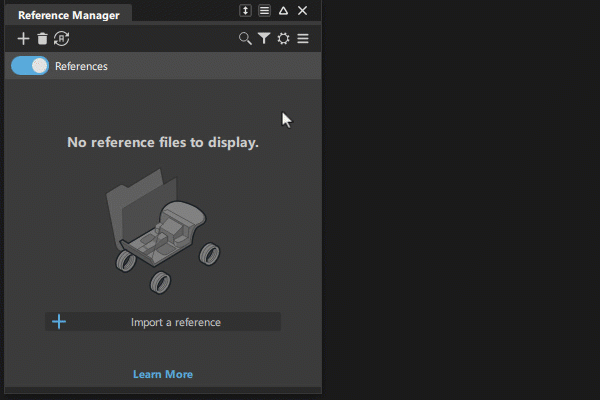
In the Reference Manager More menu, choose Set Reference Directories.
In the Set Reference Directory window, click Add Directory icon (
 ) and then browse to directory you want to use as a reference directory.
) and then browse to directory you want to use as a reference directory.If you add more than one directory, set one as the WREF save directory by clicking to the left of it.
All newly imported references will now be saved to this location.
2. Set translation options for converting geometry to WREF files
The reference translation settings described in this section are used when you select Import File, Re-Import Selected Files, and Batch Translate from the Reference Manager as well as when you select File > Import > As Reference from the Alias menu.
The translation options used to import a reference are stored in the .wref file. This means that when you update references after the source files are changed, the same options are used to retranslate. If you need to change the settings for a particular file, it can be done with Re-Import Files option.
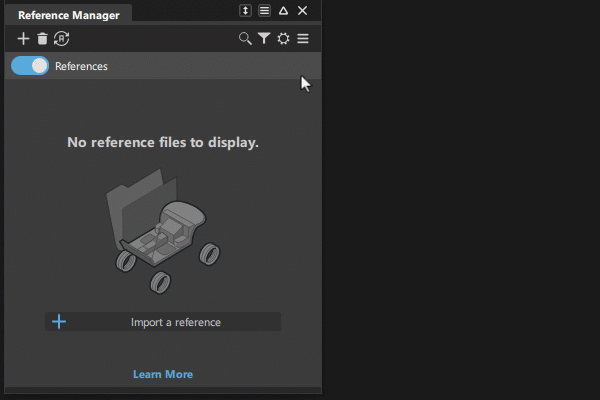
From the Reference Manager More menu, select Translation Options. The Reference Translation Options window opens.
Under WREF Options, set the values for converting the source files to .wref files.
If you are importing a supported non-native file, such as a .catia, set the import options in Reference Translation Options window.
After the initial translation, you can modify the settings, and then use File > Re-Import to retranslate the file with the modified settings.
3. Import geometry as reference files
When you import geometry as a reference, Alias converts the geometry to .wref files using the settings in the Reference Translation Options window.
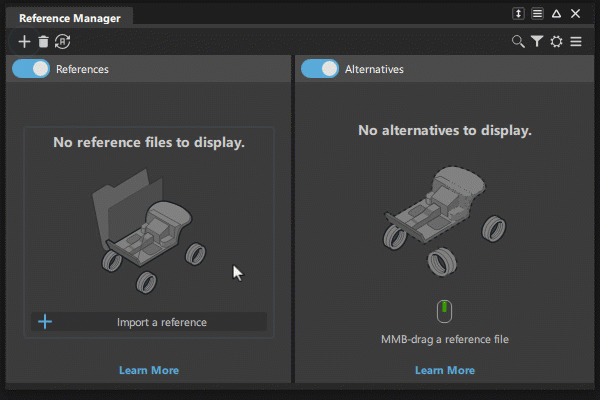
- To import geometry as a reference, do either or the following:
- In the Reference Manager, click the
 icon or select Import Files from the More menu.
icon or select Import Files from the More menu. - From the Alias menu, select File > Import > As Reference.
- In the Reference Manager, click the
- Browse to the geometry files you want to import.
The selected files are converted to .wref files and saved to the designated output reference directory. The reference geometry appears in the viewport and the Reference Manger now displays your referenced files.
By default, the layer colors assigned to source files in the Object Lister display in the Reference Manager for reference files. This includes layer folder colors and the wireframe draw color used to display reference objects in the viewport. You can assign new layer colors to references in the Reference Manager. When you do this, the new layer color is overlaid on the original layer color. To remove the new color overlay and return to the original layer color, select the layer, and then select Edit > Reset Layer Color from the Reference Manager menu.
 + dragging them up or down.
+ dragging them up or down.Modify the appearance of reference data
To make it visible or invisible – Click the small square to the left of the data. You can also right-click the reference file or Alternative and choose Visible from the context menu.
Note: Reference geometry remains visible in the viewport after turning off the model wireframe draw (Display > Show> Model).To make the current reference data visible and all other siblings invisible – Alt-click the small square to the left of the data.
To make all reference data visible or invisible – Shift-click the small square to the left of the data.
To change its color – Right-click on the small square to the left of the file name, and select a color from the lister. To remove the new color overlay and return to the original layer color, select the layer, and then select Edit > Reset Layer Color from the Reference Manager menu.
To change the transparency of reference objects– Use the Reference Surface, Reference Curves, or Reference Mesh Transparency sliders in the Control Panel.
Batch-convert geometry to reference files
You can convert multiple geometry files to references and save them to a reference directory. If you have not already done so, set the translation options for converting the geometry.

In the More menu, select Batch Translator.
In the Reference Batch Translator window, Use Reference Directory is selected by default. This indicates the reference files will be saved to the designated Reference Directory.
If you want to save the reference files to another location, clear the check-box, and then click the Browse icon beside Pick Output Directory to specify a new location.
To add the files you want to translate, click the (../images/icon_editor-toolbar-new.png) icon and browes to the files.
The file translation starts automatically.
Import converted WREF files
After you convert geometry to .wref files, you can import them into the scene from the Reference Manager.
To import the files from the Reference Batch Translator window, do one of the following:
Click the import icon:
 .
.Right-click a file and select Import.
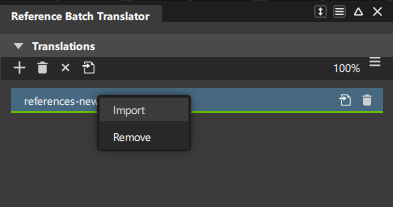
Reference Assemble workflows
About reference assemblies and reference hierarchies
You can import references that contain other references to create a hierarchy of referenced data, consisting of the top level reference and descendant references. This includes reference assemblies from the CATIA V5 and JT file formats.When working with hierarchal references, take note of the following:
- When importing a reference that has child references, only the original references are included in the hierarchy. Alternatives of the child references are not added.
- Updating a reference file updates all references in the hierarchy including the child references. Any transformations applied to the child references are overwritten.
- Only top-level references can be removed. You cannot remove child references from a parent reference file.
- You cannot import a file that contains a circular reference. Circular references occur when a referenced file is referenced by a child reference lower in the hierarchy. The Reference Manager flags circular references with this icon
 and does not import the file. To import the file, you must first remove the circular reference.
and does not import the file. To import the file, you must first remove the circular reference. - Alternatives created from multi-level references include all the reference in the hierarchy.
Add a child reference to a referenced file

You can add a reference to a file that is already imported in your scene as a reference. Doing this lets you create a hierarchy of referenced data consisting of the top level reference and descendant references. Hierarchal references are also known as reference assemblies.
If you have not already done so, import your references using the Reference Manager (see Work with reference data), and then follow these steps to add a child reference.
In the Reference Manager, select the reference to which you want to add a child reference.
Right-click and choose Open Source File from the context-menu.
The reference's source .wire file opens in a new stage.
In the new stage, import the reference you want to add to the hierarchy. For example, the file you want as the parent reference.
Save the scene.
Switch back to the previous stage.
In the Reference Manager, update (
 ) the parent reference to which you added the child reference.
) the parent reference to which you added the child reference.Your reference hierarchy is now updated with the new child reference.
Tip: If the source file of a child reference is modified, this icon displays at the parent levels of the assemble to indicate that the child reference is out of date and needs to be refreshed. Click the
displays at the parent levels of the assemble to indicate that the child reference is out of date and needs to be refreshed. Click the  icon beside the child reference to update it.
icon beside the child reference to update it.
Reference Alternative workflows
Create Alternatives
If the Alternatives pane is not yet open in the Reference Manager, select Alternatives from the Settings menu.
Select a file in the Reference Manager window, and then MMB drag it into the Alternatives pane.
Alternatives of the reference files are created and appear under an Alternatives group. Alternatives are labeled Alternative, Alternative #1, Alternative #2, and so on. If no reference files were selected, the Alternative will be empty.
The new alternative is selected in the view windows. You can transform it, shade it, and hide/show some of its files of file layers. This allows you, for example, to display different versions of a part located in separate layers of a reference file by creating three alternatives of it and showing/hiding different layers in each.
Delete Alternatives
- To delete a reference file from an Alternative, right-click the file and select Remove File From Alternative.
- To delete an Alternative, right-click the Alternative and select Remove Alternative.
You can also use the Remove Selected from the More menu or click the Delete ![]() icon to remove selected Alternatives or reference files.
icon to remove selected Alternatives or reference files.
Promote reference data
Promote reference curves and NURBS surface to geometry
Select reference data by doing one of the following:
- From the Pick tool palette, select Pick Reference >
 , choose the appropriate Pick Level option, and then select a reference object in the scene.
, choose the appropriate Pick Level option, and then select a reference object in the scene. - In the Reference Manager select the reference object or the file, layer, or layer folder containing the objects you want to promote.
- From the Pick tool palette, select Pick Reference >
From the Reference Manager More menu, select Promote > Geometry.
Select from the following Promote Geometry options:
- Promote Layer Structure with Promote Groups turned on (this is the default setting)
- Promote to Creation Layer
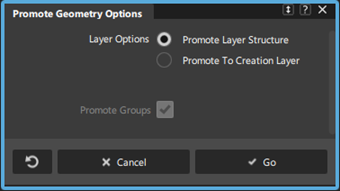
Using the information in the table below, select the appropriate Promote Geometry layer option to satisfy the desired promotion result.
Note: Regardless of your selection, a group node is created to hold the results of the promotion for each selected item.
| Reference selection | Promote to Creation Layer result | Promote Groups result | Promote Layer Structure result |
|---|---|---|---|
| File |
|
|
|
| Layer folder |
|
|
|
| Layer |
|
|
|
| Component |
|
|
|
Promote subdivision references to geometry
You can promote references containing subdivision object to real subdivision geometry. Promoted subdivision geometry includes the object's faces and the control cage as well as any crease information. All the subdivision objects in your selection get promoted to geometry. For example, if you select a file, all the referenced subdivision objects get promoted, and if you select a layer or group, objects in the layer or group get promoted. Note the following:
- Selecting a single limit surface results in the promotions of the control cage and all other associated limit surfaces.
- Any hybrid modeling operations applied to the referenced subdivision object are not preserved in the promoted geometry.
Select reference data by doing one of the following:
- From the Pick tool palette, select Pick Reference >
 , choose the appropriate Pick Level option, and then select a subdivision reference object in the scene.
, choose the appropriate Pick Level option, and then select a subdivision reference object in the scene. - In the Reference Manager, select the reference object or the file, layer, or layer folder containing the objects you want to promote.
- From the Pick tool palette, select Pick Reference >
From the Reference Manager More menu, select Promote > Subdiv.
The reference objects are copied as real geometry to the creation layer in the Object Lister.
Promote a reference shader
Use Promote Shader when you want to modify the shader applied to a referenced object as well as make it available to be reused with other objects. For more information, see Promote Shader.
Choose Pick > Pick Reference.
Select a reference object which is assigned the desired shader.
From the Reference Manager More menu, select Promote > Shader.
Note: If the selected reference object already has another shader applied to it, you have the choice to either apply the newly promoted shader or not. The promoted shader is still created if you choose not apply it to the reference.
The prompt line displays the number of shaders created and the number of reference objects that were assigned promoted shaders. The promoted shaders are applied to the reference objects and now appear in the Multi-lister. You can now use the Multi-lister to modify the promoted shaders and apply them other objects.
Pack reference data
A saved wire file only contains pointers to any reference data, not the data itself. The Pack functionality allows you to get all your data in one place for easy transfer.
- Choose Pack from the Reference Manager More menu.
- In the Pack window, browse to the location where you want the information to be stored, and enter a name for the new pack folder in the Object name field.
- Click Select
- The wire file and all reference files are saved in the specified folder. You now have all your data in one location for easy transfer.

 to open the Promote Geometry Options window, and choose how your reference geometry gets promoted. Select from the following options:
to open the Promote Geometry Options window, and choose how your reference geometry gets promoted. Select from the following options: